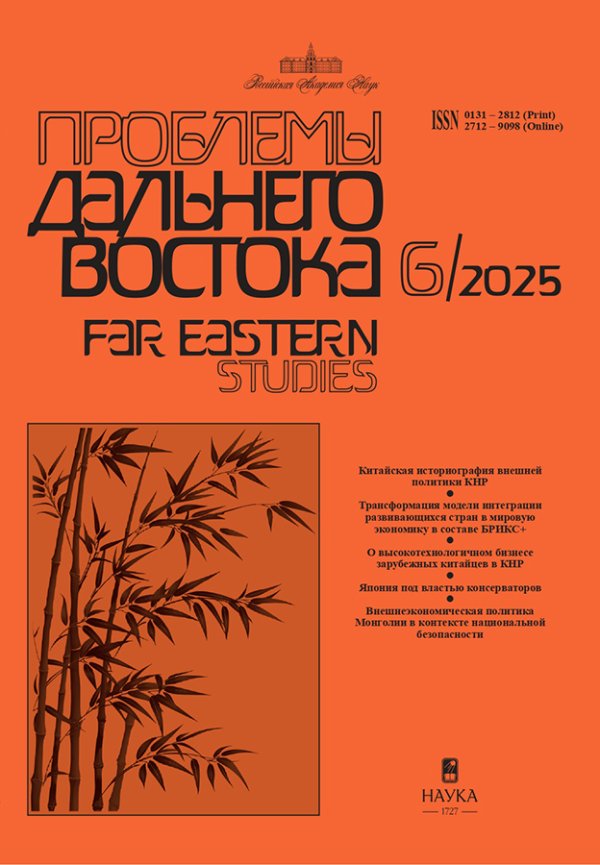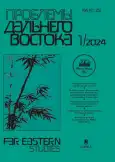Zheng He — Sinbad’s Prototype? (A Critique of a Popular Viewpoint)
- Authors: Kolnin I.S1,2
-
Affiliations:
- Institute of Oriental Studies of the Russian Academy of Sciences
- National Research University “Higher School of Economics”
- Issue: No 1 (2024)
- Pages: 139-152
- Section: History
- URL: https://journals.rcsi.science/0131-2812/article/view/259529
- DOI: https://doi.org/10.31857/S0131281224010118
- ID: 259529
Full Text
Abstract
In modern popular literature, blogs on the Internet and other media aimed at the mass reader one is more and more likely to find an assumption that the famous Chinese admiral of the Ming dynasty, Zheng He (1371—?), could be the prototype of the legendary Arab merchant and traveler Sinbad, whose seven fantastic voyages were subsequently included in the collection of folktales “One Thousand and One Nights”. This article analyzes the historical, textual and linguistic arguments for and against such a presumption from both the Chinese and Arab-Persian sides. The first part presents a general criticism of this hypothesis, after which the three main arguments of its supporters are examined separately. The author comes to the following conclusions: it is most likely that the cycle about Sinbad was formed much earlier than the expeditions of Zheng He on the basis of various myths and a self-sufficient Arab-Persian geographical and nautical tradition; the generally accepted statement that both personalities made seven voyages is in fact very controversial; Sanbao was the name given not only to Zheng He, but also to other officials at the Ming court, including those who were in no way connected with the expeditions to the Western Ocean, and the history of the appearance and use of this expression is very vague. Thus, the desire to see Zheng He as a source of inspiration for the creation of the character of Sinbad the Sailor seems groundless, and the arguments in its favor do not stand up to scientific criticism.
Keywords
About the authors
I. S Kolnin
Institute of Oriental Studies of the Russian Academy of Sciences; National Research University “Higher School of Economics”
Author for correspondence.
Email: minmi98@yandex.ru
ORCID iD: 0000-0003-0084-0272
Junior Researcher; Postgraduate student
Moscow, Russian FederationReferences
- Бокщанин А.А. Внешняя политика, войны, дипломатические и торговые посольства минской империи // Хрестоматия по истории Китая в средние века: (XV—XVII вв.). М.: Издательство Московского университета, 1960. С. 81–94.
- Боревская Н.Е. Некоторые аспекты философско-религиозной концепции романа Ло Маодэна «Плавания Чжэн Хэ по Индийскому океану» («Саньбао тайцзянь ся Сиян тунсу яньи») // Теоретические проблемы изучения литератур Дальнего Востока. М.: Наука, 1970. С. 75–82.
- Бузург ибн Шахрияр. Чудеса Индии / Пер. с арабского Р.Л. Эдлих. М.: Издательство восточной литературы, 1959. 132 с.
- Кобзев А.И. Рецензия на книгу: Ло Маодэн. Сказ о походе Чжэн Хэ в Западный океан: сокращенное издание. В 2 т. / Пер. с кит. Н.Е. Боревской. М.: Шанс, 2023 // Проблемы Дальнего Востока. 2023. № 5. С. 180–184. doi: 10.31857/S013128120028243-8
- Кривошеева М.В. Диковинные люди, животные и демонические существа в работах исламских космографов на примере трактата «‘Аджа’иб аль-махлукат» Закарии аль-Казвини / ВКР. М.: НИУ ВШЭ, 2020. 176 с.
- Мухаммад аз-Захири ас-Самарканди. Синдбад-наме / Пер. М.Н. Османов. М.: Издательство восточной литературы, 1960. 311 с.
- Пропп В.Я. Исторические корни волшебной сказки. Л.: Издательство Ленинградского университета, 1946. 340 с.
- Шумовский Т.А. Арабское мореплавание до ислама // Страны и народы Востока. 1959. № 1.С. 162–193.
- Braida E. Christian Arabic and Garšūnī Versions of Sindbad the Sailor: An Overview // The Polish Journal of the Arts and Culture. New Series 3. 2016. No. 1. Pp. 7–28. doi: 10.4467/24506249PJ.16.001.5134
- Casanova P. Notes sur les Voyages de Sindbad le Marin // Bulletin de l'Institut Français d'Archéologie Orientale du Caire. 1922. No. 20. Pp. 113–199.
- Duyvendak J.J.L. The True Dates of the Chinese Maritime Expeditions in the Early Fifteenth Century // T’oung Pao. 1939. Vol. 34. No. 5. Pp. 341–413.
- Jost A. “He Did Not Kiss the Earth Between His Hands”: Arabic Sources on the Arrivals of the Zheng He Fleet in Aden and Mecca (1419–1432) // Early Global Interconnectivity across the Indian Ocean World. Vol. 1: Commercial Structures and Exchanges. Ed. Schottenhammer A. London: Palgrave Macmillan, 2019. Pp. 79–98. doi: 10.1007/978-3-319-97667-9_4
- Kurz J.L. Making History in Borneo: Ong Sum Ping and His Others During the late Yuan and Early Ming Dynasties // International Journal of Asia Pacific Studies. 2018. Vol. 14. No. 2. Pp. 79–104. doi: 10.21315/ijaps2018.14.2.4
- Marzolph von U. An Early Persian Precursor to the Tales of Sindbād the Seafaring Merchant // Zeitschrift der Deutschen Morgenländischen Gesellschaft. 2017. Vol. 167. No. 1. Pp. 127–141. doi: 10.13173/zeitdeutmorggese.167.1.0127
- Morreale D. The Seven Voyages of Zheng He: The Real Sinbad the Sailor. Beijing: China Intercontinental Press, 2021. 132 p.
- Ong Tae Hae. The Chinaman Abroad, or, a Desultory Account of the Malayan Archipelago, Particularly of Java. Shanghae: Mission Press, 1849. 80 p.
- Papelitzky E. The Knowledge of Late Ming Literati about Zheng He’s Visits to Siam. A Comparison of the Xiyang ji and Historical Geographical Texts // Crossroads — Studies on the History of Exchange Relations in the East Asian World. 2018. Vol. 17–18. Pp. 1–25.
- Pomerantz M.A. Tales from the Crypt: On Some Uncharted Voyages of Sindbad the Sailor // Narrative Culture. 2015. Vol. 2. No. 2. Pp. 250–269. doi: 10.13110/narrcult.2.2.0250
- Seagrave S. Lords of the Rim: The Invisible Empire of the Overseas Chinese. New York: G.P. Putnam's Sons, 1995. 354 p.
- Simon R. Sindbad the Survivor // Acta Orientalia Academiae Scientiarum Hungaricae. 2000. Vol. 53. No. 1/2. Pp. 107–120. doi: 10.1556/aorient.53.2000.1-2.6
- Wade G.P. Yong-le: Year 22, Month 1, Day 27 // Southeast Asia in the Ming Shi-lu: An Open Access Resource. 2005. URL: https://epress.nus.edu.sg/msl/reign/yong-le/year-22-month-1-day-27 (дата обращения: 06.03.2024).
- Willmott D.E. The Chinese of Semarang: a Changing Minority Community in Indonesia. Ithaca, New York: Cornell University Press, 1960. 374 p.
- 南京市博物馆, 江宁区博物馆: 南京市祖堂山明代洪保墓. Наньцзин ши Цзутаньшань Миндай Хун Бао му : [Наньцзин ши боугуань, Цзяннин цюй боугуань. Гробница минского Хун Бао у горы Цзутаншань в городе Нанкин] // 考古. 2012. 第5期. 第41–52页.
- 四次元的口袋. 郑和竟然是辛巴达的原型,《一千零一夜》里第二个中国人. Чжэн Хэ цзинжань ши Синьбада дэ юаньсин, «И цянь и е» ли дэ ди эр гэ Чжунго жэнь : [Сыцы юань дэ коудай.
- Чжэн Хэ — действительно прообраз Синдбада, второй китаец в «Тысяче и одной ночи»] // 今日头条. 2020. URL: https://www.toutiao.com/article/6838652259060941315/ (дата обращения: 05.03.2024).
- 吴聿明: 周闻夫妇墓志铭. Чжоу Вэнь фуфу мучжимин : [У Юймин. Эпитафии Чжоу Вэня и его супруги] // 文物. 1985年. 第6期. 第86–88页.
- 吴之邨: 郑和 “三保” 名号考. Чжэн Хэ «Саньбао» минхао као : [У Чжицунь. Исследование прозвища Чжэн Хэ «Саньбао»] // 海交史研究. 1999年. 第1期. 第82–101页.
- 范中义: “三保太监”名号的由来. «Саньбао тайцзянь» минхао дэ юлай : [Фань Чжунъи. Происхождение прозвища «Саньбао тайцзянь»] // 历史研究. 1982年. 第2期. 第144–145页.
- 郑鹤声, 郑一钧: 郑和下西洋资料汇编. 上册. Чжэн Хэ ся Сиян цзыляо хуйбянь. Шанцэ : [Чжэн Хэшэн, Чжэн Ицзюнь. Собрание материалов об экспедициях Чжэн Хэ вниз в Западный океан. Т. 1]. 济南: 齐鲁书社, 1980年. 327页.
- .ﺩﻫﺨﺪﺍ ﻧﺎﻣﮥﻟﻐﺖ // Синдбад] имени [Значение ﺳﻨﺪﺑﺎﺩ ﻣﻌﻨﯽ URL: https://dehkhoda.ut.ac.ir/fa/dictionary/%D8%B3%D9%86%D8%AF%D8%A8%D8%A7%D8%AF (дата обращения: 06.03.2024).










